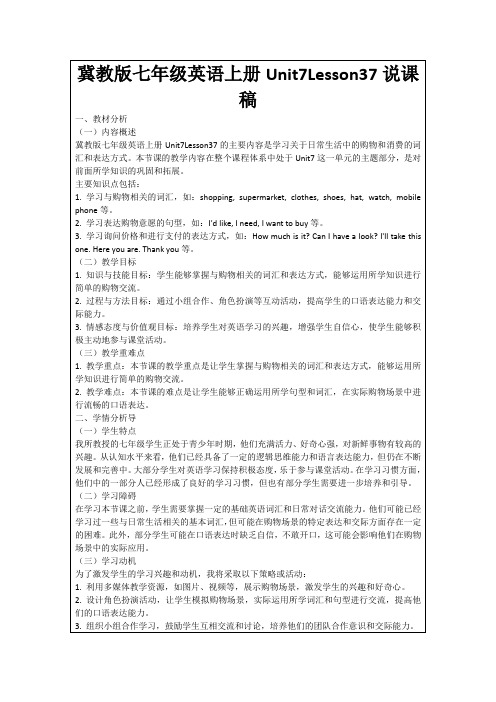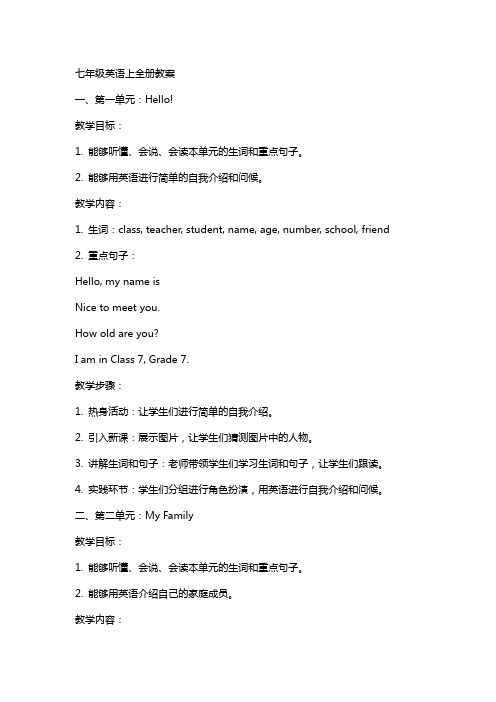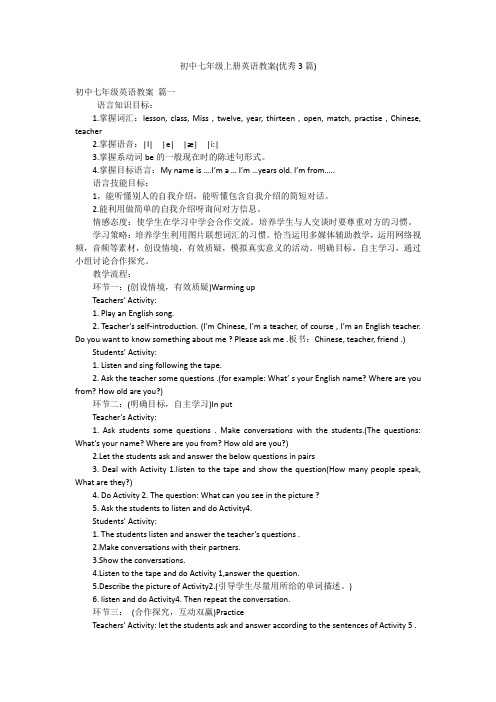七年级英语上册教案37〔优秀篇〕
冀教版七年级英语上册Unit7Lesson37说课稿

三、教学方法与手段
(一)教学策略
在本节课中,我将采用情境教学法、交际法和学生中心教学法等主要教学方法。情境教学法通过模拟真实的购物场景,让学生在实际语境中学习和应用英语词和句型,提高他们的口语表达能力。交际法强调师生之间的互动和交流,鼓励学生积极参与课堂对话,培养他们的交际能力。学生中心教学法注重学生的主动参与和自主学习,通过小组合作、角色扮演等活动,激发学生的学习兴趣和动力。
冀教版七年级英语上册Unit7Lesson37说课稿
一、教材分析
(一)内容概述
冀教版七年级英语上册Unit7Lesson37的主要内容是学习关于日常生活中的购物和消费的词汇和表达方式。本节课的教学内容在整个课程体系中处于Unit7这一单元的主题部分,是对前面所学知识的巩固和拓展。
主要知识点包括:
1.学习与购物相关的词汇,如:shopping, supermarket, clothes, shoes, hat, watch, mobile phone等。
(二)学习障碍
在学习本节课之前,学生需要掌握一定的基础英语词汇和日常对话交流能力。他们可能已经学习过一些与日常生活相关的基本词汇,但可能在购物场景的特定表达和交际方面存在一定的困难。此外,部分学生可能在口语表达时缺乏自信,不敢开口,这可能会影响他们在购物场景中的实际应用。
(三)学习动机
为了激发学生的学习兴趣和动机,我将采取以下策略或活动:
四、教学过程设计
(一)导入新课
为了快速吸引学生的注意力和兴趣,我计划采用多媒体课件展示一幅购物场景的图片,并提问学生:“你们最喜欢去哪里购物?为什么?”让学生分享他们的购物经历和喜好,引发他们的兴趣和思考。然后,我会展示一些购物场景的图片,并引导学生用英语描述他们所看到的物品和价格,激发他们对本节课主题的兴趣。
人教课标版七年级上册英语全册教案

人教课标版七年级上册英语全册教案篇一:新人教版七年级英语上册全册教案Starter Unit 1Good morning.1. Good morning/afternoon/evening. 早上(上午)/下午/晚上好。
答语相同。
称呼语放在问候语之后且用逗号隔开。
如:Good morning , class!同学们,早上好!△Good night!晚安(晚间告别用语)2. Hello, Frank! 你好,弗兰克。
3. A: How are you? 你(身体)好吗?我很好,谢谢。
你呢?A: (I‘m)fine/OK, too. 我也很好。
4. thanks = thank you 谢谢Starter Unit 2What‘s this in English? 1. What‘s this/that? 这/那是什么?What is = what’单数物品(△不说This/That is...)This、that是指示代词这、这个 this指近的 that指远的1) What‘s this/that? 这/那是什么? 2)What‘s this/that? 这/那是什么?a ruler. (这/那是)直尺。
(这/那是)苹果。
2. What‘s this/that in English? 这/那用英语怎么说?a/an + 单数物品(△不说This/That is...)What‘s this in English? 这用英语怎么说?It’s a jacket. 夹克衫What‘s that in English? 那用英语怎么说?It’s an orange. 橘子。
in + 语言:用某种语言 in 为介词 in Chinese/English/Japanese用汉/英/ 日语3. a 和an是不定冠词,只用在可数名词单数前面,表示―一‖。
a用在以辅音音素开头的单词前;an用在以元音音素开头的单词前。
七年级英语上全册教案

七年级英语上全册教案一、第一单元:Hello!教学目标:1. 能够听懂、会说、会读本单元的生词和重点句子。
2. 能够用英语进行简单的自我介绍和问候。
教学内容:1. 生词:class, teacher, student, name, age, number, school, friend2. 重点句子:Hello, my name isNice to meet you.How old are you?I am in Class 7, Grade 7.教学步骤:1. 热身活动:让学生们进行简单的自我介绍。
2. 引入新课:展示图片,让学生们猜测图片中的人物。
3. 讲解生词和句子:老师带领学生们学习生词和句子,让学生们跟读。
4. 实践环节:学生们分组进行角色扮演,用英语进行自我介绍和问候。
二、第二单元:My Family教学目标:1. 能够听懂、会说、会读本单元的生词和重点句子。
2. 能够用英语介绍自己的家庭成员。
教学内容:1. 生词:father, mother, brother, sister, grandparent, cousin2. 重点句子:This is myHe/She is myThey are my教学步骤:1. 热身活动:让学生们带来家庭成员的照片,用中文介绍。
2. 引入新课:展示图片,让学生们猜测图片中的人物关系。
3. 讲解生词和句子:老师带领学生们学习生词和句子,让学生们跟读。
4. 实践环节:学生们分组进行角色扮演,用英语介绍自己的家庭成员。
三、第三单元:What Color Is It?教学目标:1. 能够听懂、会说、会读本单元的生词和重点句子。
2. 能够用英语描述物体的颜色。
教学内容:1. 生词:red, yellow, blue, green, black, white, purple, orange2. 重点句子:What color is it?It's教学步骤:1. 热身活动:让学生们带来不同颜色的物品,用中文描述。
七年级英语上册 Unit 7 Lesson 37 Seasons and Weather教案 (新版)冀教版

Unit 7 Days and months本单元介绍了一些季节、天气、星期和月份的英文表达法,教授学生谈论天气,要求学会用英语表达在不同的天气、不同的季节从事不同的活动;学生还可以学到中国和外国一些节日的表达方法和庆祝方法;使学生了解英语与汉语在表达日期方式上存在的差异,并了解各个国家的气候差异。
学生在本单元中,要了解有关序数词的构成;掌握月份和天气的表达方式,了解如何用英语表示中国的节日。
一、教材分析1教学目标●语言知识熟练掌握本单元的重点单词和重要词组。
要求学生能听懂、会说、识记这些词汇。
●语言技能教师根据课文内容提出相关讨论问题,启发学生逐步了解一些有关天气、节日的相关知识,并能通过对比,得出中国和其他国家在这些方面的不同之处,从而进一步了解世界文化。
通过课堂的师生互动过程,运用已有的语言知识进行交流与讨论,培养学生的语言表达及语言运用能力,促进学生口语交际能力的提升。
●情感态度目标1)关注学生的情感,营造宽松、民主、和谐的氛围,进一步提高学生对英语的学习热情,增强学习兴趣。
培养学生积极主动地参与课堂活动,大胆开口,积极讨论。
2)结合中外节日,使学生们在不同的文化背景之下学习和掌握世界文化。
●学习策略以学生为主体,以能力培养为宗旨,创设多种多样的方式和机会让学生通过自主、合作、探究等学习方式来获得新知识。
注重教与学的互动和生生互动,将集体学习与小组学习相结合。
2教学重点Learn some new words about seasons, weather, days, months and holidays.Know the difference in weather, holidays and so on between China and other countries. 3教学难点1) Some new words and phrases.2) Some knowledge about season and weather二、教学准备多媒体课件、录音机、日历或挂历三、具体教学步骤Lesson 37: Seasons and WeatherClass OpeningGreeting1. Give the standard greeting to welcome students to English class.2. Ask and answerWhat day is it today?How is the weather?What season do you like?Key conceptsPart I What season do you like?Step I Guessing Game1. Show some pictures to the students and ask the students to guess which season it is.Questions:1) What can you see in the picture?2) What season is it?2. After the game, the teacher and the students do some ask and answer practice about seasons, such as:How many seasons are there in a year?What are they?What’s the weather like in spring/summer/autumn/winter?...Step II New Concepts1. Learn all the new words and explain some language points.2 .Read and remember all the new words.Step III Listen and read1.Listen and MatchListen to the first part and do No.1 on Page 99.2.Read and Answer!1)Read part 1 as quickly as possible and do No.2 on page 99.2)Read part 1 again and answer the questions:Who is in the story?What are they talking about?What weather does Wang Mei /Li Ming/Li Lin like best? Why?3.Read and Act out!The teacher asks the students to read part 1 in pairs and act it out in the class! Step IV Grammar ExplainingExplain the grammar of “it”.Use Chinese if necessary.Part II How is the weather?Step I Enjoy an English Poem1.Listen to part 22.Read aloud with it.Step II Memory Game---What we heard just now?1. The teacher first shows the pictures and three questions:What day is it today?How is the weather?What can we do?2.The teacher asks the students to answer all the questions without books.3.Chant this poem aloud.Step III Class activitiesI. Survey and ReportHelp the students do a survey by asking and answering in English in a group of ten. The question is: What weather do you like best?Instruct the students to report the result to the class like this:In our group, ______(数字)students like the _______(sunny/windy/cloudy/rainy/snowy) days.So, most students like _____ days in our group.II. Work in pairs.Work in pairs and do the No.4 on Page 99.A: what do you like to do in summer?B:I like to go swimming and eat ice cream. What about you?A: I like to...Class ClosingHomework:1. Complete No.4 on Page 99.2. Do No.3 on Page 99.3. Read the text and recite all the new words.。
冀教版英语七年级上册Lesson37教学设计

3.教师邀请几位学生分享他们的描述,并对他们的回答给予积极评价。
4.引导学生关注家庭成员活动中的动作,导入本节课的主题:“We will learn how to describe the daily activities of family members using the simple p、语调的敏感度,提高英语听力理解能力。
(二)过程与方法
1.通过小组合作、角色扮演等方式,让学生在实际情境中运用所学知识,提高英语口语表达能力。
2.利用多媒体教学资源,如图片、音频等,引导学生积极参与课堂活动,提高课堂学习效果。
3.设计丰富的课堂活动,如任务型教学、讨论等,培养学生自主学习、合作学习和探究学习的能力。
2.完成教材课后练习题,包括填空、选择和改错等类型,巩固一般现在时态的用法。
3.学生以小组为单位,编写一段关于家庭成员日常活动的对话,尽量使用本节课所学的单词和短语。要求每个成员都参与其中,下节课进行展示。
4.家长协助孩子拍摄一段家庭成员日常活动的视频,时长约1-2分钟。学生观看视频后,用英语进行简单介绍,描述家庭成员在视频中的活动。
4.培养学生热爱英语学习,增强学习英语的自信心,提高跨文化交际能力。
二、学情分析
本节课的教学对象为七年级学生,他们在前期的英语学习过程中,已经掌握了基本的英语语法和词汇,具备了一定的听说读写能力。在此基础上,学生对一般现在时态有所了解,但对于其在具体情境中的运用还不够熟练。此外,学生在家庭生活方面的词汇量和表达能力有待提高。
(五)总结归纳,500字
1.教师引导学生回顾本节课所学内容,包括一般现在时态的用法、家庭成员日常活动的描述等。
2.学生分享学习心得,总结自己在课堂上的收获和不足。
冀教版七年级英语上册教案Unit 7 Lesson 37

Unit 7 Days and monthsLesson 37 Seasons and weather本课时的教学内容是冀教版七年级上册英语第七单元的第一课时,重点在于引导学生理解语境,从表示季节的词开始,自然地导入谈论天气和季节的话题。
以描述四季作为任务引起学生的听说兴趣,训练学生的听力和口语表达能力。
利用动作、手势和图片学习英语单词,同时在对话中反复运用新学的单词和短语。
【知识与能力目标】掌握单词: Monday, rainy, Tuesday, outside, Wednesday, Thursday, snowy, skate短语: green grass, rainy days, go swimming, in summer, have a good time, go skating, etc.【过程与方法目标】Reading and listening.【情感态度价值观目标】能够描述四季的天气以及进行的相应活动。
【教学重点】能使用基数词和序数词。
【教学难点】能听懂关于日期、季节和天气的对话。
图片,PPTStep 1. Lead inLeading in 【情景1】Let’s begin a free talk. The teacher and students look out of the window. The teacher asks them to talk about what season it is. What do they do in this season?T: Hello,boys and girls.Look out of the window now.How’s the weather?Ss: It’s sunny.T: Is it windy?Ss: Yes,it is.T: What can we do on these days?S1: I can fly kites.S2: I like to play in the park.S3: I like to go shopping with my friends.Leading in 【情景2】The teacher asks some students to describe the features of the season. Ask the students to guess what the season it is.S1: It’s very hot.We can get much rain in this season.Ss: It’s summer.S2: It’s a good season.Everything begins to grow.Ss: It’s spring.S3: It’s a beautiful season.We can see snow.Ss: It’s winter.S4: In this season,we can see colourful leaves.Ss: It’s autumn/fall.Step 2. Presentation1.Lead the students to learn new words with objects or pictures. Ask the students to makesentences with the new words. The teacher can ask them questions according to the situations.(Monday)T: What do you do on Monday?S1: I go to school on Monday.T: Now read after me,“Monday”.Ss: Monday.2.Practice the conversations in pairs. Use the following sentences:What day is it today?It’s Monday today.How is the weather?It’s snowing.What season do you like?I like spring.Step 3. Listening1.Listen and answer the following questions:(1)What day is it today?(2)How’s the weather?(3)What season does Wang Mei like?【Keys】(1) It’s Monday. (2) It’s snowing. (3) Winter.2.Ask the students to listen to the tape and try to imitate it. Pay attention to the pronunciation and intonation.Step 4. ReadingAfter listening to the conversations, get the class to read them aloud.Step 5. Practice1.Students read the passage aloud. Focus on the stressed words, pronunciation and intonation.2.Ask some students to act the dialogue out in front of the class.3.Show different pictures of different seasons. Ask them questions like these:(1)What day is it today?(2)How is the weather?(3)What can we do?S1: It’s Tuesday.It’s rainy, but I have to go to school. I want to work hard at school.Step 6. Complete Let’s Do It!Ask the students to listen to the tape and finish Exercise 1.What day is it? How is the weather? Listen to the dialogues and match the day of the week with the weather.We have finished Exercise 2 in the reading part. Let the students finish Exercise 3 in class. Check the answers in class.Step 7. TaskStep 8. ExercisesStep 9. Homework略。
英语七年级上册《lesson37》教案

3).你呢?________________4).呆在里面__________
5).玩的开心______________6).去滑冰____________
7).snowy days____________ 8).play outside ________
Season
Favourite things
summer
go swimming, eat ice cream
Example :
A:What do you like to do in summer?
B: I like to go swimming and eat ice
cream. What about you?
B. New lesson.
Step 1.Present learning -aims.(1')
Step 2. New Words(5')
Learn the new words using the pictures.
Step3:Listening
Listen and match the day with the weather. (Let's Do It Part1).(3')
What day is it today?
How is the weather?
Language points
1.What’s the weather like? / How is the weather? 2.描述天气的形容词。
交际用语
A: What do you like to do in summer?
Key structures: What season do you like ?
初中七年级上册英语教案(优秀3篇)

初中七年级上册英语教案(优秀3篇)初中七年级英语教案篇一语言知识目标:1.掌握词汇:lesson, class, Miss , twelve, year, thirteen , open, match, practise , Chinese, teacher2.掌握语音:|І||e||æ||i:|3.掌握系动词be的一般现在时的陈述句形式。
4.掌握目标语言:My name is ….I’m a … I’m …years old. I’m from…..语言技能目标:1,能听懂别人的自我介绍,能听懂包含自我介绍的简短对话。
2.能利用做简单的自我介绍呀询问对方信息。
情感态度:使学生在学习中学会合作交流。
培养学生与人交谈时要尊重对方的习惯。
学习策略:培养学生利用图片联想词汇的习惯。
恰当运用多媒体辅助教学,运用网络视频,音频等素材,创设情境,有效质疑,模拟真实意义的活动。
明确目标,自主学习,通过小组讨论合作探究。
教学流程:环节一:(创设情境,有效质疑)Warming upTeachers’ Activity:1. Play an English song.2. Teacher’s self-introduction. (I’m Chinese, I’m a teacher, of course , I’m an English teacher. Do you want to know something about me ? Please ask me .板书:Chinese, teacher, friend .) Students’ Activity:1. Listen and sing following the tape.2. Ask the teacher some questions .(for example: What’ s your English name? Where are you from? How old are you?)环节二:(明确目标,自主学习)In putTeacher’s Activity:1. Ask students some questions . Make conversations with the students.(The questions: What’s your name? Where are you from? How old are you?)2.Let the students ask and answer the below questions in pairs3. Deal with Activity 1.listen to the tape and show the question(How many people speak, What are they?)4. Do Activity 2. The question: What can you see in the picture ?5. Ask the students to listen and do Activity4.Students’ Activity:1. The students listen and answer the teacher’s questions .2.Make conversations with their partners.3.Show the conversations.4.Listen to the tape and do Activity 1,answer the question.5.Describe the picture of Activity2.(引导学生尽量用所给的单词描述。
- 1、下载文档前请自行甄别文档内容的完整性,平台不提供额外的编辑、内容补充、找答案等附加服务。
- 2、"仅部分预览"的文档,不可在线预览部分如存在完整性等问题,可反馈申请退款(可完整预览的文档不适用该条件!)。
- 3、如文档侵犯您的权益,请联系客服反馈,我们会尽快为您处理(人工客服工作时间:9:00-18:30)。
Lesson 29 A Birthday Card
【教学目标】
1.能够掌握课标要求的“四会”词汇:paper,inside,poem,rose,present,soft。
2.让学生了解一些有关制作贺卡的口语。
【教学重难点】
1.掌握一些与贺卡制作有关的词汇:make,card,picture,write,draw。
2.激发学生兴趣,让学生了解更多关于生日祝福的口语。
3.掌握以下重点句子:
①Jenny is making a birthday card for her.
②And inside the card her family will write something for Grandma.
③She is using paper and crayons to make the card.
④Happy birthday!
⑤Have a wonderful birthday!
【教学准备】
录音机、幻灯片、图片
┃教学过程设计┃
一、创设情境,切入主题
Step 1:Lead-in
Show the pictures in the lesson to the students.Let them guess:
1.What can we write on the birthday card?
2.How can we celebrate the birthday?
Let the students answer the questions in class.
二、展开过程,探究新知
Step 2:Listening
Listen to the tape and fill in the blanks with the correct words you hear.
1.Jenny is making________for her grandma.
2.Mary Smith________a riddle on the card.
Finish the task in class orally.
Step 3:Reading
Read the lesson and decide the following statements are true or false.
1.Jenny makes a birthday cake for her grandma.
2.Bob writes a poem for his grandma.
Finish the task in class orally.
Step 4:Practice
Work in groups and practice the lesson.Then act it out in front of the class.When they act,they can use their own words.
Read the lesson again and find more questions about it.
S1:What is Jenny painting on the front of the card?
S2:Who writes a riddle for Grandma?
Step 5:Activities
Suppose you want to make a birthday card.But you don’t know what to do.How can you do?Ask your classmates for advice.
Finish the task in groups.Then after a few minutes,let some students act out their passage in front of the class.
Step 6:Come to “Let’s Do It!”
Listen to the tape and finish Exercise 1 together.Read the lesson again and answer the questions in Exercise 2.
Finish Exercise 3 together.
三、布置作业
Finish Exercise 4 in “Let’s Do It!”.
【板书设计】
Lesson 29 A Birthday Card
1.Words:
paper,inside,poem,rose,present,soft
2.Sentences:
Jenny is making a birthday card for her.
And inside the card her family will write something for Grandma.
Happy birthday!
Have a wonderful birthday!。
